Looney Tunes Diorama
I’ve always admired the aesthetic of the backgrounds that take up a lot of the space of Looney Tunes cartoons. There actually used to be an Instagram account dedicated to showcasing these backgrounds, but I believe it got taken down due to copyright issues. This takedown was probably justified, but it still left me longing for some kind of showcase of this art. At some point, I’d love to see an exhibit that celebrates Looney Tunes backgrounds or just cartoon backgrounds from that era. Scooby Doo has some incredible artwork too, and it’s displayed in an Instagram account called scooby_scapes. I recommend checking it out.
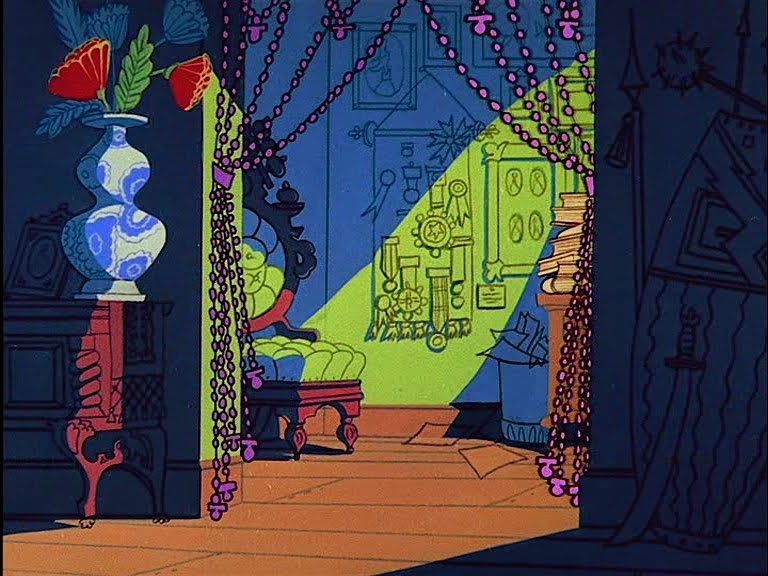
This is a frame from the Looney Tunes Episode “Deduce, You Say”, drawn by Chuck Jones.
After staring at Looney Tunes backgrounds from the aforementioned Instagram account and also from the cartoons themselves for a long time, I’ve been able to categorize what I think makes them distinct from other aesthetics.
First, they have very exaggerated proportions. The views of every object, building, and character are unrealistic but believable. They make the viewer feel like they’re looking at something from the perspective of a child. When we’re young, our brains don’t know how to interpret everything we’re looking at, so our imaginations run wild, and everything is more interesting and appealing. A building might look comically tall, or a train track might have absurdly steep grades. I think some real-life objects achieve this effect without any work. Desk lamps tend to look somewhat lifelike, and I feel that they look exaggerated and act as characters.
Second, Looney Tunes backgrounds have very stark shadows. These shadows are much more pronounced than in real life. They tend to drastically change the color of objects that they cover, or they are completely black. I find that some of my favorite photographers also tend to focus on very stark contrasts between dark areas and light areas.
Lastly, Looney Tunes backgrounds tend to feature very warm and comfortable colors. No matter the setting of the cartoon, they always seem cozy and like a desirable place to be in. The colors also often take up large areas. The backgrounds are not terribly detailed but still evoke strong feelings.
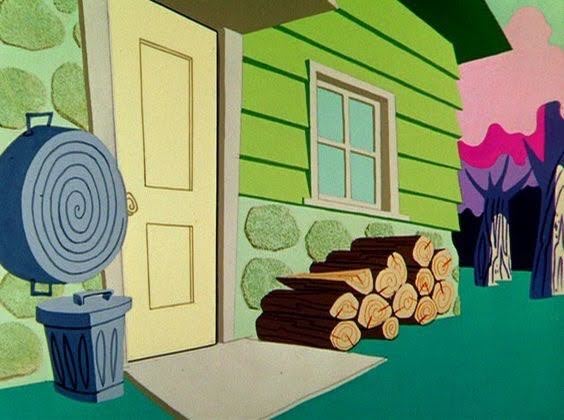 This is a frame from the Looney Tunes episode “Red Riding Hoodwinked”, drawn by Chuck Jones. I think it shows all 3 elements that I mentioned. The door is exaggerated, the trash can has stark shadows, and the colors on the house are pastel and comforting.
This is a frame from the Looney Tunes episode “Red Riding Hoodwinked”, drawn by Chuck Jones. I think it shows all 3 elements that I mentioned. The door is exaggerated, the trash can has stark shadows, and the colors on the house are pastel and comforting.
For my project, my goal was to create a situation that looks like it could have come out of a Looney Tunes cartoon. I planned to use a desk lamp, a cardboard box, construction paper, some paint, and some electronics. The box acts as a base for everything to sit on and for any special effects to be hidden inside of. The desk lamp is not actually on, but the inside is painted yellow. The area that the lamp would be shining on is a yellow circle except for a small creature-shaped hole in the top of the box. Originally, I was thinking that the viewer would look inside the hole and see 2 illuminated eyes, but that would be big of a scope for my liking, and I settled for everything that I have already mentioned. I also wanted to put a pair of tiny, broken handcuffs on the table, but I cut this out of the final project as well. The overall idea is that some evil being has escaped from the handcuffs, and a small innocent creature has escaped by jumping through the box.
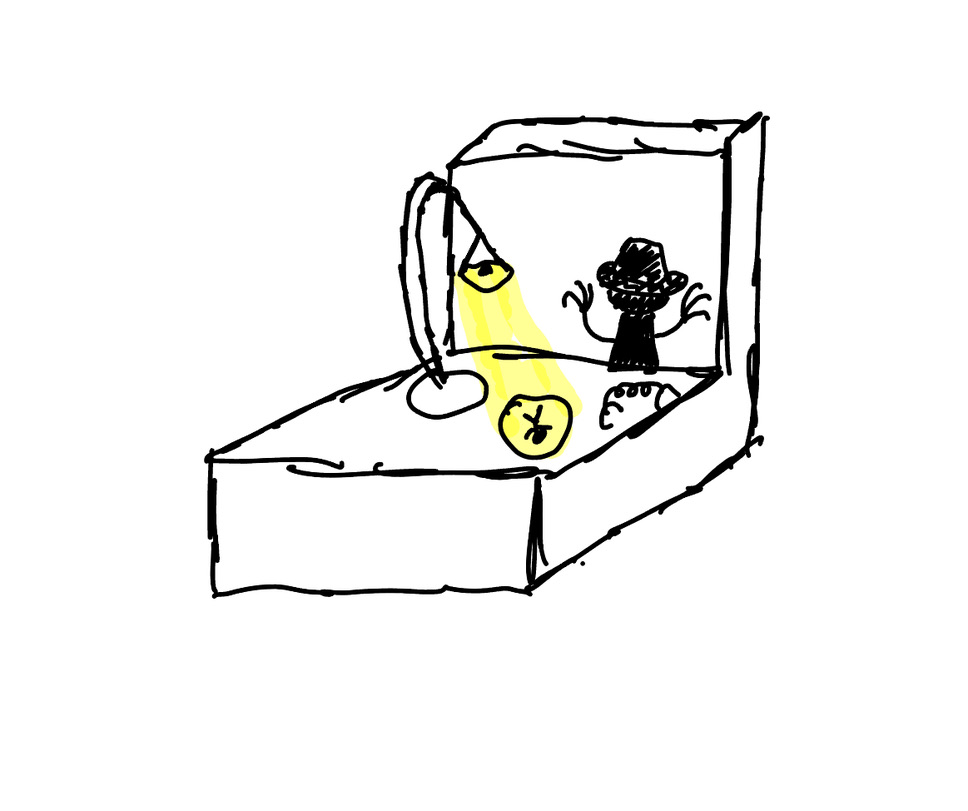
The above image is my initial design concept for the project.
I constructed the entire diorama in one day. It was very fun, and I want to make more things that are similar. I started with a Converse shoebox that I had been using to store some electronics. There were some holes in the top of the box that I covered with Gaff tape. I spray-painted most of the box black and painted the lid white. I wanted the focus of the viewer to be on the lid of the box, and I wanted the rest of it to be seemingly nonexistent. The only tools that I used on the entire project were a leatherman, a crescent wrench, and a hobby knife. I used the leatherman to cut a hole in the rear left corner of the shoebox lid, which I planned to use for installing the lamp. The lamp that I used was a pink desk lamp from Goodwill. I removed the weighted base from the lamp which turned out to be filled with some kind of concrete that had disintegrated over time. That was an annoying mess to clean up. I used the non-weighted plastic part of the base as a large washer to spread out the surface area that the bottom of the lamp took up. This keeps the lamp from tipping over. I attached foam core to the sides of the lid to act as walls. To make the lamp appear on but in a cartoonish way, I painted the inside yellow. I also painted an area on the lid yellow to look like the lamp was shining on it. I cut a little creature-shaped hole out of the yellow area to look like something had jumped through it, and I painted a black shadow arm on the wall behind the lamp.
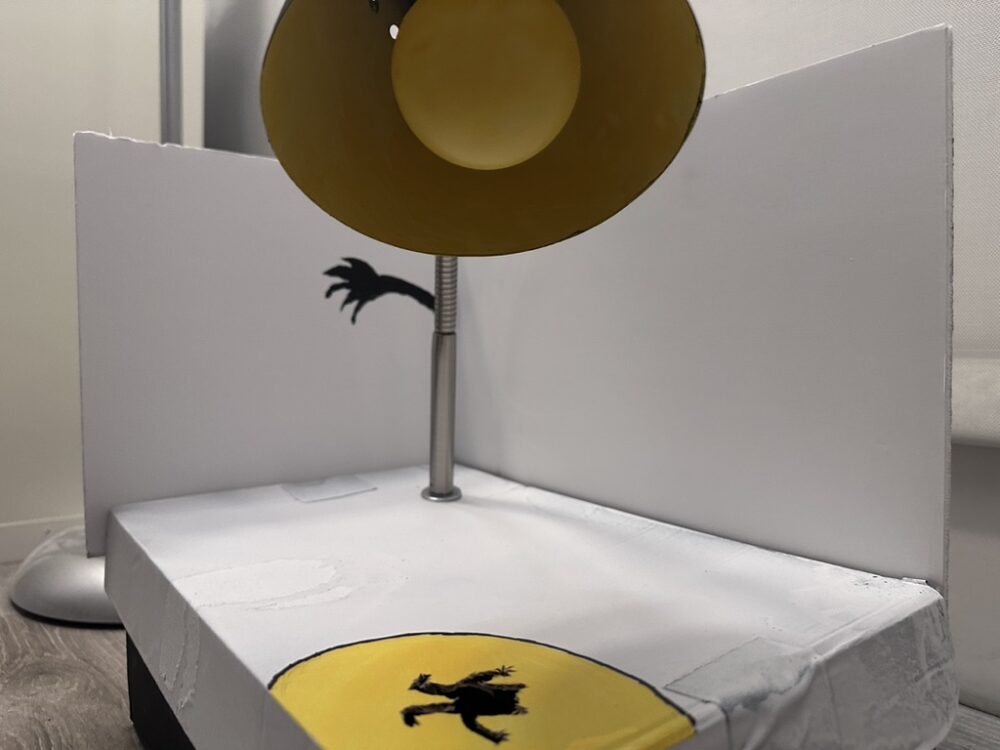
The above image shows an overview of my diorama.
One thing that I wanted to achieve with this project was more of a freeform approach to design. I only did one sketch and did not make any CAD drawings. This is considerably less planning than I normally do for any project, and it felt sort of freeing. I based everything on my initial sketch and didn’t look back. I made cuts as I went if I deemed something unnecessary or too difficult, such as the LEDs and the handcuffs. I feel that the removal of the LEDs actually adds to the upcycled nature of the diorama because the electronics and Arduino would have been off-the-shelf items. Another thing that I changed was the shadowy figure on the backing piece. He became just a large, black arm. This was easier to make and added an air of mystery to him. The viewer can see the arm and ask, “What’s back there? Is it dangerous?” I also decided that a second backing piece would be necessary to make the diorama feel like an enclosed space. The viewer can still look inside and appreciate what they see, but they can still understand the need for the smaller creature to escape by jumping through the floor.
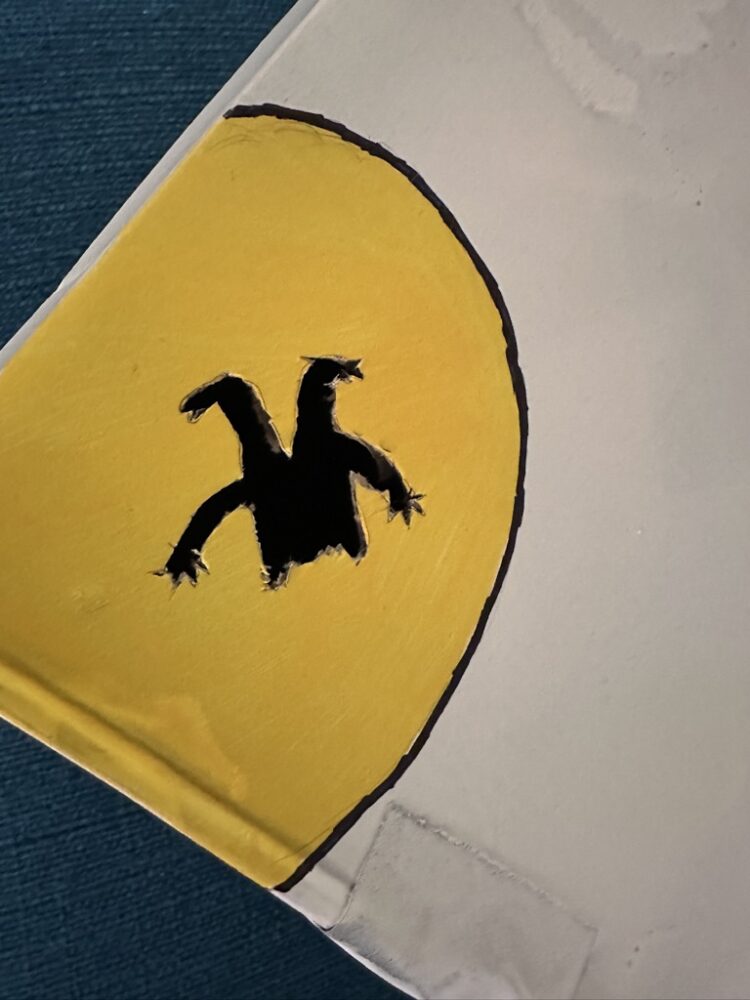
The above image shows the hole that the creature seemingly jumped through and the area around it painted yellow.
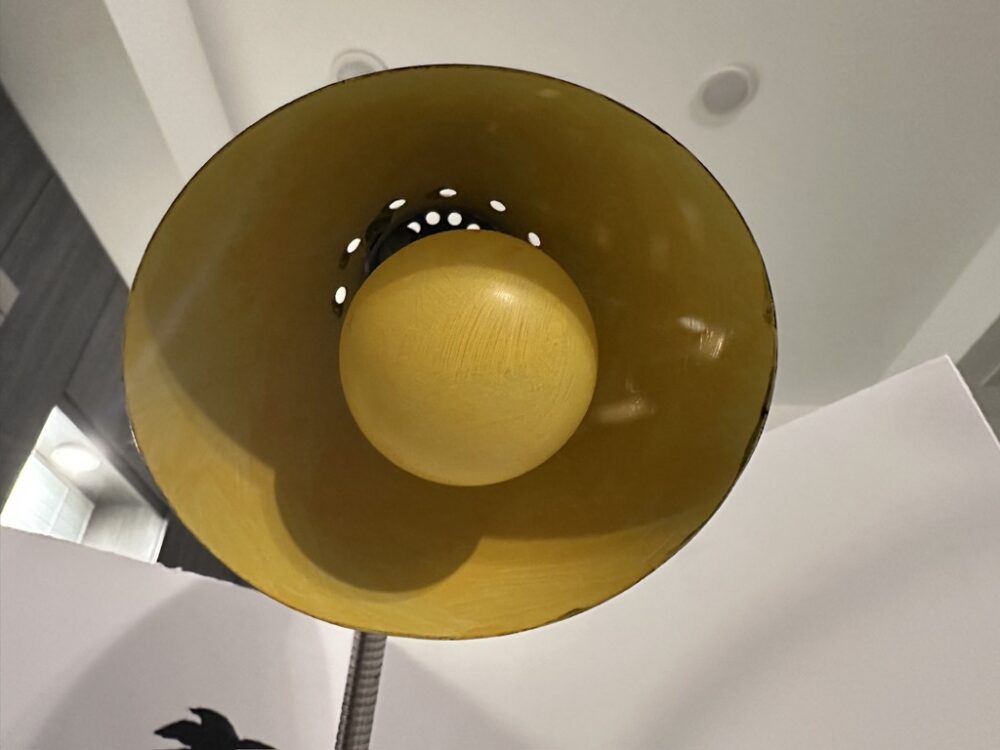
The above image shows the inside of the lamp with yellow paint.
In terms of functional goals, I didn’t achieve everything I wanted because I didn’t include the LED eyes. With that said, I don’t think this would have been much of an improvement to the project. The LEDs and Arduino, as mentioned previously, would not have been upcycled. I am very proud of the fact that the only non-upcycled things in the project are adhesives and paint. I also think that it would have been difficult for the viewer to see the LEDs inside the box, and I don’t know how obvious the effect that they were supposed to convey would have been. In addition, I would have had to black out the area around the LEDs so that the inside of the box looked like a void. In the future, I could see myself trying to use 0402 surface-mounted micro LEDs instead of the 3-millimeter ones that I was originally going to use. These would be easier to put close together and would be dimmer than the 3-millimeter ones.
In terms of artistic goals, I achieved everything I wanted. The viewer can look at the diorama and get a sense of exactly what I was going for. There is a clear storyline throughout it that is comical and comfortable. If anything, it reminds me of the cartoons I used to watch as a child and transports me back to that time. I don’t think that the addition of the LEDs would have improved the project artistically. I also don’t think the handcuffs would have improved it. These would have been confusing for the intended purpose, and I’m not sure how I would have made them.
I think in the future I will not change my project. I was planning on ripping out the Arduino after using it on this project, and I think I’ll just skip the middle part. I could end up using the Arduino in my final project for this course. I would also love to reuse the lamp for something else, but I don’t think I can make it function again. The entire inside is painted yellow, the wires have been ripped out, and the weight for the base fell apart. I would like to find a place to put the diorama in my apartment where it can be on display. I’m very proud of how it turned out, and I am very happy that I made it.
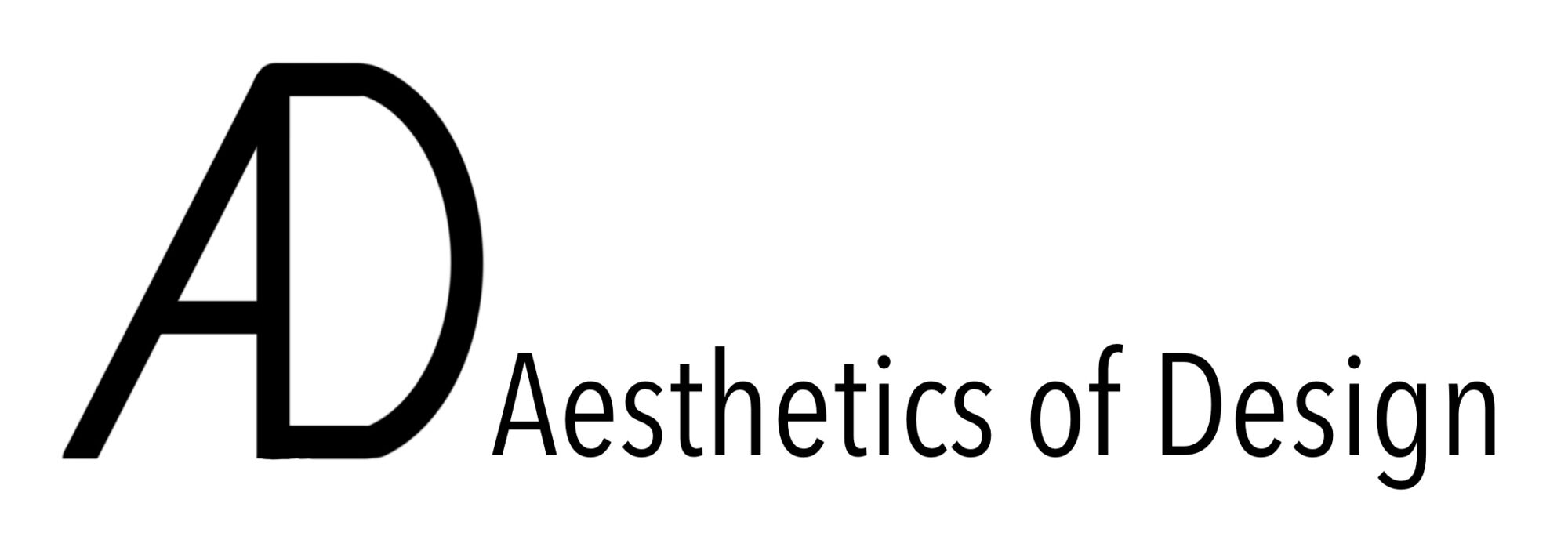
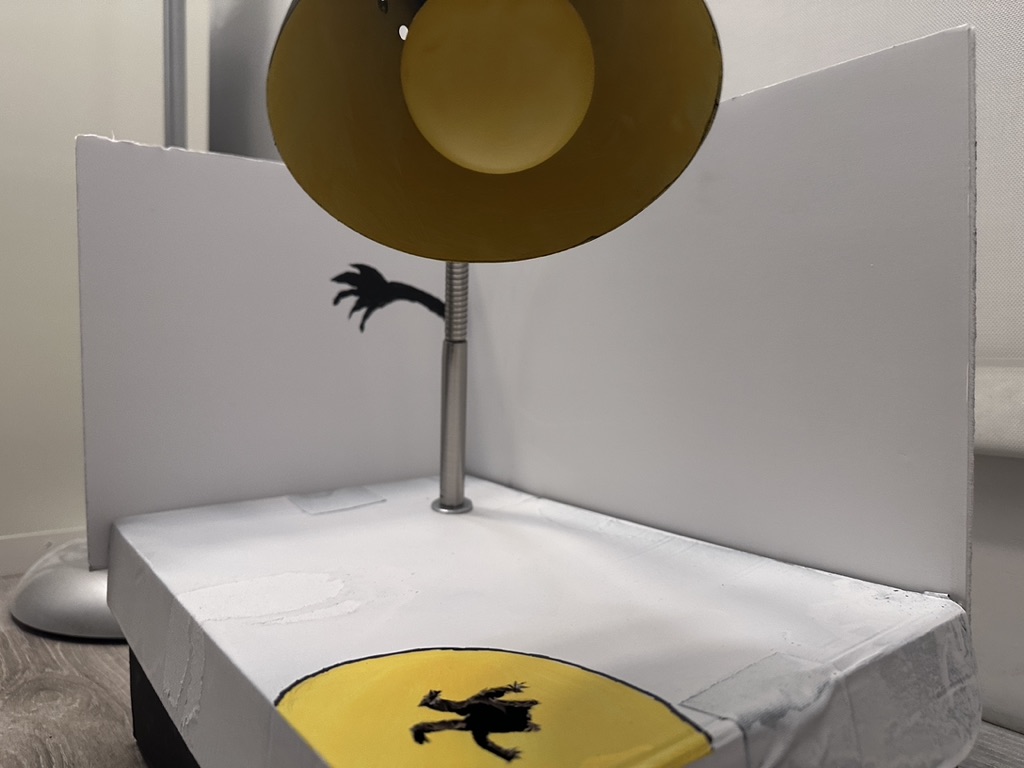
2 Comments. Leave new
This is awesome. I think you did a really good job. I am wondering though, in your description you mention how the backgrounds always had vivid and comfortable colors. Why did you decide to paint the majority of your project white? I was kind of expecting to see some vibrant colors and zany shapes.
Hey Sam, I commented on your initial project idea post and I’m happy to see the final result! I think that the goal of the aesthetic has mostly been reached, I would’ve loved a few more blocky shapes (nature, objects, etc) in those contrasty colors that the cartoons have. I would probably display this in my own home, and I love funky little projects like this!